
Marshmallow is a confectionery made from sugar, water and gelatin whipped to a solid-but-soft consistency. It is used as a filling in baking or molded into shapes and coated with corn starch. This sugar confection is inspired by a medicinal confection made from Althaea officinalis, the marsh-mallow plant.
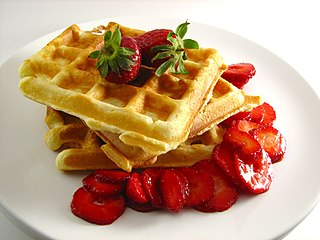
A waffle is a dish made from leavened batter or dough that is cooked between two plates that are patterned to give a characteristic size, shape, and surface impression. There are many variations based on the type of waffle iron and recipe used. Waffles are eaten throughout the world, particularly in Belgium, which has over a dozen regional varieties. Waffles may be made fresh or simply heated after having been commercially cooked and frozen.

Pralines are confections containing nuts – usually almonds, pecans and hazelnuts – and sugar. Cream is a common third ingredient.

In cooking, syrup is a condiment that is a thick, viscous liquid consisting primarily of a solution of sugar in water, containing a large amount of dissolved sugars but showing little tendency to deposit crystals. In its concentrated form, its consistency is similar to that of molasses. The viscosity arises from the multiple hydrogen bonds between the dissolved sugar, which has many hydroxyl (OH) groups.

Fudge is a type of confection that is made by mixing sugar, butter and milk. It has its origins in the 19th century United States, and was popular in the women's colleges of the time. Fudge can come in a variety of flavorings depending on the region or country it was made; popular flavors include fruit, nut, chocolate and caramel. Fudge is often bought as a gift from a gift shop in tourist areas and attractions.

A squib is a miniature explosive device used in a wide range of industries, from special effects to military applications. It resembles a tiny stick of dynamite, both in appearance and construction, but has considerably less explosive power. A squib consists of two electrical leads separated by a plug of insulating material; a small bridge wire or electrical resistance heater; and a bead of heat-sensitive chemical composition, in which the bridge wire is embedded. They can be used to generate mechanical force to shatter or propel various materials; and for pyrotechnic effects for film and live theatrics.
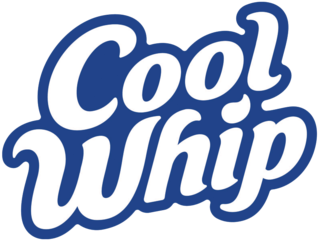
Cool Whip is an American brand of whipped topping manufactured by Kraft Heinz. It is used in North America as a topping for desserts, and in some no-bake pie recipes as a convenience food or ingredient that does not require physical whipping and can maintain its texture without melting over time.

A chocolate fountain is a device for serving chocolate fondue. Typical examples resemble a stepped cone, standing 2–4 feet tall with a crown at the top and stacked tiers over a basin at the bottom. The basin is heated to keep the chocolate in a liquid state so it can be pulled into a center cylinder then vertically transported to the top of the fountain by an Archimedes screw. From there it flows over the tiers creating a chocolate "waterfall" in which food items like strawberries or marshmallows can be dipped.

Chocolate syrup is a sweet, chocolate-flavored condiment. It is often used as a topping or dessert sauce for various desserts, such as ice cream, or mixed with milk to make chocolate milk or blended with milk and ice cream to make a chocolate milkshake. Chocolate syrup is sold in a variety of consistencies, ranging from a thin liquid that can be drizzled from a bottle to a thick sauce that needs to be spooned onto the dessert item.

A thickening agent or thickener is a substance which can increase the viscosity of a liquid without substantially changing its other properties. Edible thickeners are commonly used to thicken sauces, soups, and puddings without altering their taste; thickeners are also used in paints, inks, explosives, and cosmetics.

A génoise, also known as Genoese cake or Genovese cake, is a French sponge cake named after the city of Genoa and associated with French cuisine. It was created by François Massialot in the late 17th century. Instead of using chemical leavening, air is suspended in the batter during mixing to provide volume.
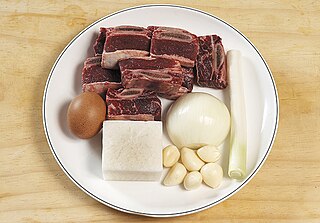
In a general sense, an ingredient is a substance which forms part of a mixture. In cooking, recipes specify which ingredients are used to prepare a dish. Many commercial products contain secret ingredients purported to make them better than competing products. In the pharmaceutical industry, an active ingredient is the ingredient in a formulation which invokes biological activity.

Buttercream, also referred to as butter icing or butter frosting, is used for either filling, coating or decorating cakes. The main ingredients are butter and some type of sugar.
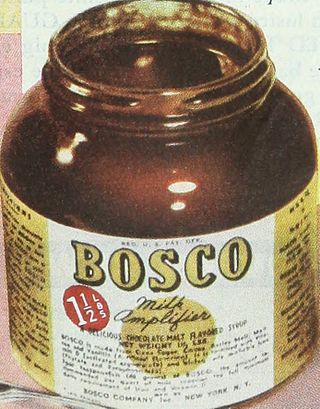
Bosco Chocolate Syrup is a brand of chocolate syrup first produced in 1928. The company, Bosco Products, Inc., is based in Towaco, New Jersey, and products are sold throughout the United States and Europe.

Chocolate is a food product made from roasted and ground cocoa pods mixed with fat and powdered sugar to produce a solid confectionery. There are several types of chocolate, classified primarily according to the proportion of cocoa and fat content used in a particular formulation.

Bodily mutilation in film describes the apparent mutilation for theatrical purposes of a character in a film. Bodily mutilation is most usually portrayed in the context of horror, but is also used in other genres, such as medical dramas or war films. It is used primarily either to shock or fascinate the audience of a film, or to add a sense of realism. Improved special effects in recent decades have seen an increase in the prevalence of bodily mutilation in film.

Candy making or candymaking is the preparation and cookery of candies and sugar confections. Candy making includes the preparation of many various candies, such as hard candies, jelly beans, gumdrops, taffy, liquorice, cotton candy, chocolates and chocolate truffles, dragées, fudge, caramel candy, and toffee.
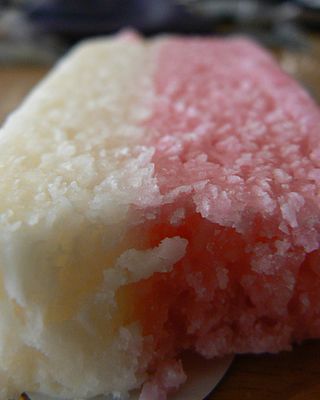
Coconut ice is a British confectionery prepared using grated desiccated coconut or just grated coconut, condensed milk and sugar, which is formed to create a solid, soft candy. It typically has a chewy, soft and mildly grainy texture; some versions are semi-hard. Coconut ice is also available in South Africa, some areas of Australia, and New Zealand.

A bullet hit squib or a blood squib is a practical, pyrotechnic special effect device used mainly in the film industry, TV shows and stage performances and even in first responder moulage training to simulate the appearance of a person being shot and wounded. This is achieved by blowing open a pre-scored hole on the actor's clothing and bursting a fake blood packet with a small explosion, creating an aesthetic that filmmakers and audiences alike have become accustomed to associating with a gunshot wound.
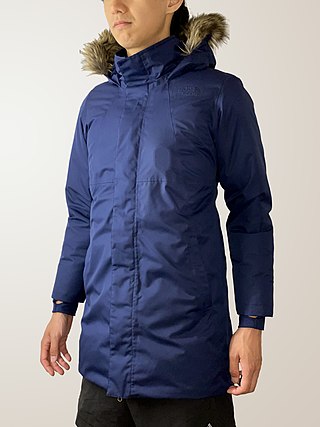
Stage clothes worn by actors who portray characters that are shot and wounded in movies, TV shows, or theatre productions are modified to conceal special effects equipment such as squibs, wires and controllers are commonly referred to as "dead-character costumes". These costumes are a crucial element to create a captivating and dramatic scene. Typically, several identical sets of these costumes are prepared for the planned number of takes as "consumables" and are used only once. After use, they are placed on the "dead-character rack" and not reused, unlike other clothing articles that return to the costume shop.






















